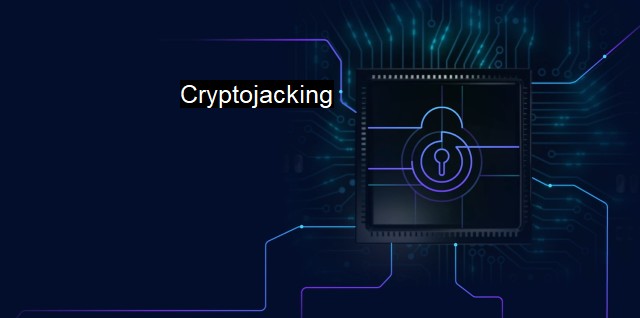What is Cryptojacking?
Cryptojacking: The New Challenge for Cybersecurity Experts and Developers of Antivirus Software
Cryptojacking is a malicious cybersecurity breach, rivaling ransomware, phishing attacks, and other forms of cybercrime in its escalating prevalence. Stemming from the surge in popularity and value of cryptocurrency such as Bitcoin, Ethereum, and Litecoin, Cryptojacking has emerged as a lucrative, underhanded method for criminals to exploit unsuspecting internet users, deriving profit from their computing resources without their consent.Cryptojacking involves the illicit use of another person's computer to mine cryptocurrency. In simple terms, mining refers to the computational process through which digital transactions are verified and added to the blockchain or public ledger, with the miner being rewarded with a small portion of cryptocurrency in exchange for their effort. This process consumes considerable computational resources and electricity. Unwilling to cover these costs themselves, some individuals exploit the computers of others to do the mining, which is where the term "Cryptojacking" comes in.
The execution of Cryptojacking relies heavily on stealth. Hackers employ various strategies to infect target computers, most commonly via malicious emails known as phishing attacks or through malicious websites. Once these malicious codes infiltrate a target system, they silently siphon its computational power, directing it towards their cryptocurrency mining activities while remaining virtually undetectable to the unsuspecting user. The primary telltale sign of an infected computer is often a noticeable slowdown in performance or a sudden, unexplained surge in electricity consumption.
Despite its potential harm to individuals and corporations, Cryptojacking is often labeled as a "low-risk" cybercrime due to its elusive nature. Because Cryptojacking doesn't directly raid financial or personal information like most traditional forms of cybercrime, users are often unaware they've been victimized until significant system slowdown or high electricity costs prompt an investigation. This stealthy, seemingly non-invasive demeanor makes Cryptojacking an appealing strategy for attackers.
Organizations can fall victim to Cryptojacking when attackers target their desktops, laptops, and even servers, pooling together their immense computational resources for cryptocurrency mining. When such organizations fall victim to Cryptojacking, the resultant loss can be enormous in terms of both productivity and electricity cost. No organization is immune, and educational institutions, businesses, governmental agencies, and non-profit groups have all been caught in Cryptojackers' sights.
As with other forms of cybercrime, effective defenses against Cryptojacking necessitate a meticulous approach to cybersecurity. This should involve the establishment and enforcement of robust security policies, the use of updated antivirus software, regular system checks, user education, and trained IT personnel that are well versed in the latest cybersecurity threats and their corresponding countermeasures.
Antivirus software plays a critical role in the detection and eradication of Cryptojacking scripts. Some advanced antivirus programs can even prevent Cryptojacking attempts before they happen by blocking suspicious websites or other gateways through which Cryptojacking scripts typically gain their entry. Combining antivirus programs including malware detection capabilities with a proactive security strategy is an organization's first line of defense against Cryptojacking.
Cryptojacking represents an insidious threat in the cyberspace, hijacking individuals' and organizations' computational resources to selfishly mine cryptocurrency. It highlights the importance of remaining vigilant against ever-evolving cyber threats. Consequently, an investment including quality antivirus software, is not only prudent but necessary in this digital age. As with any deception-based crime, awareness can be the key to prevention, and vigilance can combat this subtle yet potentially costly cyber-related menace.

Cryptojacking FAQs
What is cryptojacking?
Cryptojacking is a type of cyber attack where the attacker uses the victim's computer or mobile device to mine cryptocurrency without their consent or knowledge. The attacker uses malicious software to hijack the processing power of the victim's device and mine cryptocurrency for their own benefit.How does cryptojacking work?
Cryptojacking works by infecting a victim's computer or mobile device with malicious software, usually through a phishing email, a malicious website or an infected software download. The malware then runs in the background, using the victim's processing power to mine cryptocurrency. The attacker then receives the newly mined cryptocurrency into their own digital wallet.How can I protect myself against cryptojacking?
To protect yourself against cryptojacking, make sure to keep your antivirus and anti-malware software up to date, and only download software and apps from trusted sources. Avoid clicking on suspicious links or opening email attachments, and use a pop-up blocker to prevent malicious ads from appearing on your screen. You can also install browser extensions that block cryptojacking scripts from running in your browser.Is cryptojacking illegal?
Yes, cryptojacking is illegal as it is a form of cybercrime. Using someone else's computer or mobile device without their permission to mine cryptocurrency is a violation of their privacy and can cause damage to their device. In some jurisdictions, cryptojacking is considered theft and can result in criminal charges and fines.| | A | | | B | | | C | | | D | | | E | | | F | | | G | | | H | | | I | | | J | | | K | | | L | | | M | |
| | N | | | O | | | P | | | Q | | | R | | | S | | | T | | | U | | | V | | | W | | | X | | | Y | | | Z | |
| | 1 | | | 2 | | | 3 | | | 4 | | | 7 | | | 8 | | |||||||